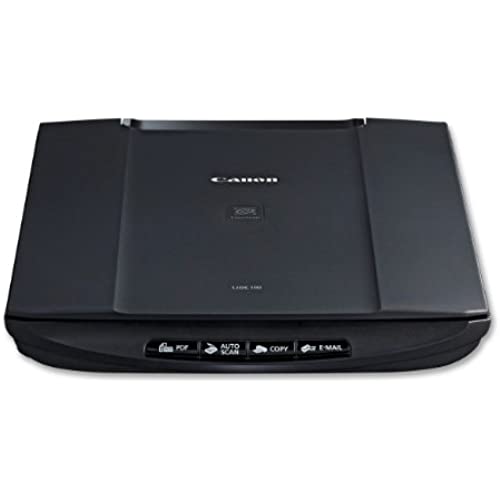
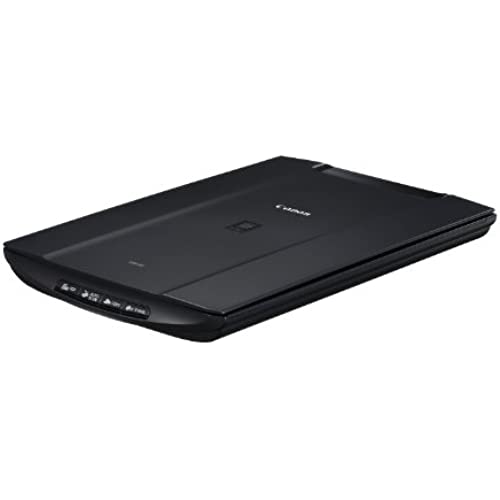
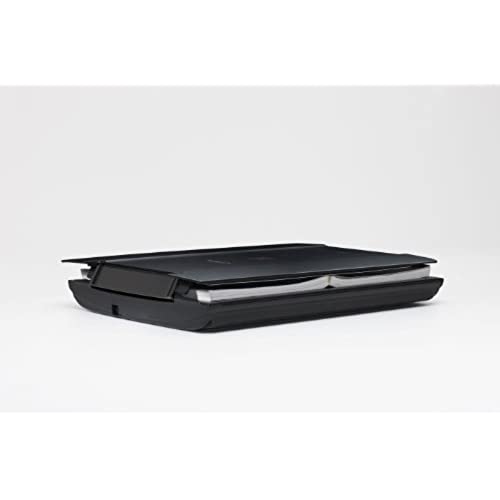
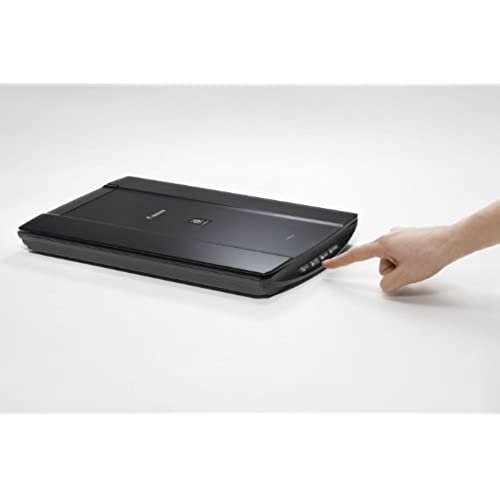
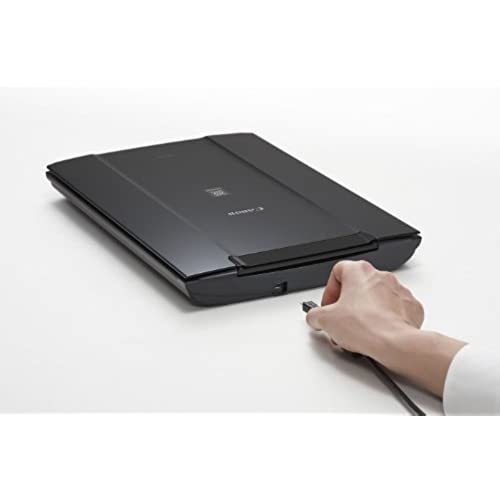





Canon 4507B002 Document Scanner
-

Jeff
> 24 hourI sought out this scanner based on the recommendation of a co-worker for its cousin, the LiDE210. I needed a relatively portable scanning solution in my over the road trucking operation for the purpose of forwarding paperwork digitally to the home office. The LiDE110 is remarkably light and compact, certainly not much larger, if any, than it has to be. Since it draws its power from the same USB port it uses for communication, its quite simple to use in a mobile environment, even when AC isnt available (so long as my laptop is charged, at any rate ... incidentally, the scanner doesnt seem to have a huge impact on the laptops battery life, either). And, as a scan resolution of 300dpi is more than sufficient for archiving documents, some of the objections other reviewers put forth about the ultimate resolution of the scanner being misleading simply dont bother me. Also, in relation to another observation I read in customer reviews prior to purchasing this unit, it was indeed initially rather noisy in operation. Since the noise level really was inconsequential to me, I had no problem with it being that way, though it certainly confirmed those reviews. However, after a few months of light to moderate use (somewhere between two and five times a week, on average), I find the unit has quieted considerably, so much so that sometimes I have to listen closely to even be sure its scanning. If this turns out to be a precursor to some sort of failure, Ill come back and edit this review, but at this point Im presuming its something to do with normal break-in of the moving parts (which, these days, tend to be more nylon and plastic than anything else). Meanwhile, its become very quiet. This product is an excellent (and cheaper) alternative to portable sheet feed scanners, which in my experience often generate unacceptable page skewing and are significantly slower in scanning a standard 8-1/2 x 11 document. For smaller documents, like cash register receipts, I can place multiple pieces on the flatbed and either scan them all at once (using image editing software to break up the resultant scan as needed) or preview the scan and select each receipt individually for its own scan. Again, its generally quicker than sheet fed scanners and avoids skewing (which is even more of a problem with small, odd-sized receipts and documents). At this point (about three months in) I am very pleased with my Canon LiDE110 and would recommend it to anyone wanting excellent basic document and image scanning, a minimal footprint and very good mobility / portability.
-

Sebastião Leonardo Queiroz
> 24 hourNone
-

ReconScout
> 24 hourI was recently looking to purchase a scanner for a family photo project in which I have to scan hundreds of images. After some research, I purchased the
-

Hayagreeva
> 24 hourI will begin with an earnest request to Canon - fire the guys who wrote the driver software. If you outsourced the job terminate the contract right away. But dont throw away the program. Use it for training purposes, it is an excellent example of how not to do the job. This convoluted pack of garbageware comes in three or four different bundles all of which install separate icons on your desktop, stay in the memory and your system tray even after you close the program till you hunt them one by one and kick them out of your system. User never gets any idea of how to move from one bundle to another (or to which one) for whatever he wants to do. You click on an icon and it takes you somewhere you dont want to be and leaves you absolutely clueless on how to get back. (After several minutes of tearing your hair you may find that there is a greyed out button you are supposed to click). Change one parameter in the advanced settings and all the others reset themselves to default. You have to set the Unsharp Mask option to ON if you want to sharpen the picture. I can go on but you get the idea, zero stars for the software. Having got that off, if I have to rate the scanner hardware by itself, I would give it five stars and more without thinking. My main reason to buy it was to scan old pictures for archival purposes and I have no complaints about picture quality. A few documents scanned also came out very well. I have not tried direct emailing or pdf conversion. The simple USB connection, small size and light weight are all of great value. Before buying I had asked a question on this forum about output file sizes. The answers unfortunately were not very illuminating. After experimenting and a bit of consultation here is a brief tutorial. Basic formula for file sizes is DPI(W) x Width x DPI(H) x Height x Colour Depth / 8 The last 8 converts bits into bytes. For example if you scan a 4 x 6 photo at 1200 DPI using 48 bit colour, your file size will be 1200 x 6 x 1200 x 4 x 48 / 8, roughly 200 MB. The 48 bits come from 3 colours @ 16 bits each. The simple Colour setting uses 8 bits instead of 16 and reduces file size by half. (But in the binary world your colour resolution is down to 256 from a massive 65536). If you scan the same photo in greyscale, that is only 8 bits of a single colour and the file size reduces to 1/6th. I have settled on 300 DPI at 48 bit colour depth which gives me 12 MB files per photo. If you are archiving photos do not use jpeg. This is a repetitively lossy format, every time you edit and save the photo you lose some picture quality. Tiff is the way to go. It is lossless and best for archiving and printing. Also Canon retains the 48 bit colour depth only for tiff, jpeg as well as bmp images are always downsized to 24 bits. Even for emailing, you are better off with tiff at a lower resolution. If you are trying to compare different formats, dont go by how the picture looks on your computer screen. A jpeg at 150 DPI and a tiff at 1200 DPI will look exactly the same on most computers. This is because monitors lack the resolution to see the difference which will show up only when you try print enlarged copies.
-

Robert A. Grossman
> 24 hourI bought this about three years ago and I use it A LOT!!! I just got done writing a review about a laptop cooler I just bought and I plugged this scanner into the laptop coolers USB port to see if it would power it. It did. But thats not whats important as it says nothing about the scanner itself. It just compelled me to come back here and write a review about this product and give it the five stars it deserves. Now, we all know its not a state of the art high definition scanner and it doesnt have a sheet feeder but let me tell you, I use it all the time and it makes great PDFs in either black and white or COLOR. There are not too many electronic products that work like brand new after three years of regular use but this is one of them. Of course it will create JPEGs and a couple other formats I think too but I seem to always use it to create PDFs and its great. Do I wish it had a sheet feeder? You bet. But look at the price of this thing! At the time of this writing its selling for about $47. This scanner is ideal for value oriented shoppers. Dont bother buying an extended warranty (dont take it personally Square Trade) if your buy this scanner. Canon makes great products, both high and low end, and theres really not much to this simple scanner so if anythings going to go wrong with it its likely it will be well within the standard warranty period (probably one year) and Canon is such a highly reputable company I dont think you need to worry about them not supporting their products in the unlikely event you ha e a warranty claim. I typically buy high end stuff but I didnt with this scanner but I absolutely love it. Ill still probably buy one with a sheet feeder and higher resolution one day and when I do, it will likely be a Canon. I own a Canon 60D camera, some very expensive Canon lenses, have owned a couple of Canon printers over the years though Im not currently using a Canon printer. The point is, all of Canons products work as advertised so you can really buy with their stuff with confidence. This great little inexpensive scanner is no exception to the high standard of quality one can expect from this company.
-

Bob
> 24 hourThe scanner head suddenly stopped moving mid scan. It almost nade it 10 years. I will have to find another solution. I really liked the portability of the scanner
-

T. Bouthillier
> 24 hourWasnt sure the best place to post all this for exposure, but I guess Amazons not a bad choice. Ive had several of these LiDE model scanners through the years, and while all have been excellent deals for the price and functionality, they do have a few quirks; thus, the reason for my review... in hopes my (successful) troubleshooting efforts will help someone else out down the road. I recently picked up this 110 after trying to swap an old 80 model I had running on a Mac (10.5.8, and in order to scan through twain in Photoshop I had to run the program in Rosetta mode... but it worked) over to a PC, and for the LiFE of me I could NOT get it to operate (and Im a certified tech). I tried various drivers, install procedure orders, different USB ports, environment variable path tips I found on the web, etc... all to no avail. It would somewhat recognize the scanner, intermittently, and sometimes start to initialize and hum, but when I tried to scan, use the bundled one-touch software (which I needed, as I primarily wanted to use it as a localized desk copier), or even run test diagnostics on it from the control panel, I simply got various errors (5.202.5, Unable to select twain source and several others depending on what I tried). I finally decided maybe it was just the combination of the old scanner/drivers and XP Pro, and ordered this 110 as a replacement. To my dismay, I only experienced the exact same issues. Luckily, I custom-built the computer I was trying to install it on a few years ago, and at the time, built several all with the same components (office environment), so I had a couple of identical spares available to test with. As such, I installed the scanner on one (or actually, two, separately) of these other boxes and it fired up and worked flawlessly (on both), first try, so I ultimately ended up swapping just the hard drive from the problematic computer to one of the ones it had installed on properly, and guess what? As hoped, it also worked perfectly on that combination... first try. So it seems that in my particular situation, the problem was nothing more than a random hardware issue... a computer with slightly underpowered USB ports (all of them). This was difficult to diagnose, as a USB powered external hard drive that we use for backups worked fine on the problematic computer, so I initially assumed the USB ports were in fine working order and not an issue. However, the hard drive was only drawing 100 mA, which the ports were apparently supplying, but apparently this scanner (and I can only assume the majority of the LiDE line) requires a full 500 mA to operate properly, which is the maximum power a USB 2.0 port (which all of mine were). This means if for whatever reason yours is only putting out 400, 450, or maybe anything less than an absolute full 500 mA (not sure what mine was delivering as I didnt bother to check once I had it up and running), youre probably going to experience issues and constant errors like I did. Another possible solution (I assume), since not everyone has a spare computer lying around? Plug it into a USB hub (preferably a USB 3.0 one, which delivers 900 mA) that has its own power supply to ensure the scanner is getting the power it needs. If i would have had one of those lying around, I would have tried it as well, but didnt. Anyway - hopefully my (month long, on and off) headache helps someone who buys one of these LiDE models, simply cannot get it to agree with your computer right out of the box, and immediately blame it on a faulty scanner. ;)
-

R. Keith
> 24 hourMy review is how well this scanner works with Debian based Linux systems! First let me say that I was bit taken back to find that the power for the scanner comes through the USB cable, not a separate power cord. I choose this product because it was listed on the SANE list of scanners as completely compatible. (If you are not familiar with Linux, SANE is an organization who has attempted to make open source based drivers for scanner and video cameras) I connected if first to my desktop running Ubuntu 14.04. Once I had installed the SANE updates, including the extras, Ubuntu recognized it. However it wasnt until after I rebooted that it became fully usable. I tried scanning documents and photos, but was not excited with the results - they were okay, but not as good as I expected. So then I installed the software that came the scanner on my laptop, running MS Windows 7, once again the results were not as good as I expected. Finally I installed the scanner on a laptop running Lubuntu - this computer is the intended final home of the scanner. Much to my surprise Lubuntu had all the correct SANE drivers installed already and the scanner output was great! Much better than I got on either my Ubuntu desktop or MS Windows 7 laptop. In theory the results on the Lubuntu laptop and Ubuntu desktop should be the same. I cant really account for the difference, although my sense is that it is a color depth issue as the scanner supports 42bit color, but none of the drivers, including the MS Windows drivers, offered that as a color depth option. Another thing that might account for the difference is the quality of the screen. My desktop is hooked up to HD compatible (1920x1080) screen, as is my MS Windows laptop. The Lubuntu laptop screen is whatever HP put on it six or seven years ago when it was new, but I know it is NOT HD compatible.
-

M. Francis
> 24 hourI recently purchased the Canon CanoScan LiDE 110 as a replacement for an older LiDE 30. This LiDEs most important features is that it is compatible with all versions of Microsoft Windows, including Windows 7 64-bit (the older version is not compatible with 64-bit versions of windows) and the fact that it is powered through the USB 2.0 cable, meaning no power supply to carry around or finding a place to plug in, a plus for use with a notebook computer. After following the directions for installation, installing the drivers before plugging the scanner into the computer, everything went flawlessly, and the first time the scanner was plugged in, after rebooting, the hardware was found and driver installed. While this can be used as a stand alone flatbed copier, it can also scan to PDF files right from a button on the front of the scanner, meaning you wont need to have a full featured PDF creation program to create PDF files. A button can also be configured to send a scan directly to your e-mail program, although I havent tried this feature. If you use this scanner in a photo editing program, such as Paintshop Pro Photo, or Photoshop, after the driver software loads, I would recommend clicking on the advanced button, as it gives you much more control over the details of the scan, which is important when scanning photos. If you havent used a scanner before, then let me recommend that you select 600 dpi as your default scanning resolution, instead of the 300 dpi selection youll see the first time you use it. Also be aware that jpg files at 600 dpi can be quite large when in color, so if you are scanning a black and white photo or document, youre better off selecting Gray Scale instead of Color. In the advanced mode, changes like DPI and color will show up the next time you use the software. If you use the basic mode, and make changes, this is not the case. Thats why I always recommend using this in the advanced mode. If youre looking for a scanner to scan 50 page documents, this is not the scanner to buy. You need one with an automatic sheet feeder, or an All-In-One with a sheet feeder. This flat bed scanner is best used for scanning photos and books.
-

Just Josh
> 24 hourThis is the perfect scanner to go with your laptop. It is very small and does not require a separate power supply. I keep mine tucked away under my desk and only take it out when I need it. That way it isnt always just consuming valuable desk space. When I need to use it all I have to do is plug it into the USB port on my computer and its ready to go! This scanner and the Canon software allows you to do multiple things. I mainly use it for scanning documents to PDFs and also for scanning in color photograph prints. As a PDF creator it is nice because you can easily convert your paper documents to PDFs for sending contracts or for just eliminating some clutter and moving your file cabinet into your computer. The only downside is that since it doesnt have any type of document feeder you have to scan each page separate which can be a little time consuming if you have large multi-page documents. For photos it works great. Im slowly converting a huge collection of family photos into digital copies so I can just manage all my new photos from digital cameras with my old photos from film on my computer in one giant library. A nice feature when scanning photos is that you can place multiple photos on the scanner at the same time and it will recognize where the edges of each photo are and automatically create separate image files for each photo. This allows you to quickly scan 3 or 4 photos at the same time. All in all this is a great little scanner and the price simply cant be beat! One piece of advice is you may need to run the platen calibration routine once you get the scanner setup. This is accessed from within the ScanGear software. I initially had an issue where my color photos had banding lines and a yellow offset to the color, but this was immediately fixed once I ran the calibration program.
